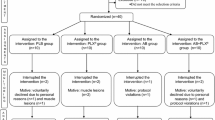Summary
Effects of 10 weeks of physical training on free radical scavenging enzyme systems in erythrocytes were investigated in 7 sedentary healthy male students. The training consisted of running over 5 km, 6 times/week. Their maximum oxygen uptake and 12 min walk-run performance increased significantly after training. Of the antioxidant enzyme systems examined in the erythrocytes, both catalase activity and concentration and total glutathione reductase (GR) activity also showed significant increases following the training. The erythrocyte GR activity coefficient also increased significantly. These results suggest that chronic aerobic exercise increases riboflavin requirements and has some positive effects on antioxidative processes.
Similar content being viewed by others
References
Bamji MS (1969) Glutathione reductase activity in red blood cells and riboflavin nutritional status in humans. Clin Chim Acta 26:263–269
Bartosz G, Tannert Ch, Fried R, Leyko W (1978) Superoxide dismutase activity decreases during erythrocyte aging. Experientia 34:1464
Belko AZ, Obarzanek E, Kalkwarf HJ, Rotter MA, Bogusz S, Miller D, Haas JD, Roe DA (1983) Effects of exercise on riboflavin requirements of young women. Am J Clin Nutr 37:509–517
Belko AZ, Obarzanek E, Roach R, Rotter M, Urban G, Weinberg S, Roe DA (1984) Effects of aerobic exercise and weight loss on riboflavin requirements of moderately obese, marginally deficient young women. Am J Clin Nutr 40:553–561
Beutler E (1975) Red cell metabolism. 2nd ed Grune & Stratton, New York
Brady PS, Brady LJ, Ullrey DE (1979) Selenium, vitamin E and the response to swimming stress in the rat. J Nutr 109:1103–1109
Clark IA, Cowden WB, Hunt NH (1985) Free radical-induced pathology. Med Res Rev 5:297–332
Cooper KH (1968) A means of assessing maximal oxygen uptake. JAMA 203:201–204
Dill DB, Costill DL (1974) Calculation of percentage change in volumes of blood plasma, and red cells in dehydration. J Appl Physiol 37:247–248
Dillard CJ, Litov RE, Savin WM, Dumelin EE, Tappel ALL (1978) Effects of exercise, vitamin E, and ozone on pulmonary function and lipid peroxidation. J Appl Physiol: Respirat Environ Exercise Physiol 45:927–932
Jenkins RP, Friendland R, Howald H (1984) The relationship of oxygen uptake to Superoxide dismutase and catalase activity in human skeletal muscle. Int J Sports Med 5:11–14
Meister A (1983) Selective modification of glutathione metabolism. Science 220:472–477
Morehouse LE (1972) Laboratory manual for physiology of exercise. CV Mosby Company, St Louis
Nichoalds GE (1974) Assessment of status of riboflavin nutriture by assay of erythrocyte glutathione reductase activity. Clin Chem 20:624–628
Ohno H, Sato Y, Yamashita K, Doi R, Arai K, Kondo T, Taniguchi N (1986) The effect of brief physical exercise on free radical scavenging enzyme systems in human red blood cells. Can J Physiol Pharmacol 64:1263–1265
Oski FA (1970) Normal red cell metabolism and the influence of age and plasma environment. In: Holmes WL (ed) Blood cells as a tissue. Plenum Press, New York, pp 99–116
Quintanilha AT (1984) Effects of physical exercise and/or vitamin E on tissue oxidative metabolism. Biochem Soc Trans 12:403–404
Quintanilha AT, Packer L (1983) Vitamin E, physical exercise and tissue oxidative damage. In: Porter R, Whelan J (eds) Biology of vitamin E (Ciba Foundation Symposium 101). Pitman Books, London, pp 56–69
Reinhart WH, Stäubli M, Straub PW (1983) Impaired red cell filterability with elimination of old red blood cells during a 100-km race. J Appl Physiol: Respirat Environ Exercise Physiol 54:827–830
Reznick AZ, Steinhagen-Thiessen E, Gershon D (1982) The effect of exercise on enzyme activities in cardiac muscles of mice of various ages. Biochem Med 28:347–352
Salminen A, Vihko V (1983) Endurance training reduces the susceptibility of mouse skeletal muscle to lipid peroxidation in vitro. Acta Physiol Scand 117:109–113
Spodaryk K, Szyguła Z, Dabrowski Z, Miszta H (1985) The activity of erythrocyte enzymes in rats subjected to running exercises. Eur J Appl Physiol 54:533–537
Stansell MJ, Deutsch HF (1966) The levels of catalase and of erythrocuprein in human erythrocytes. Clin Chim Acta 14:598–607
Tillotson JA, Baker EM (1972) An enzymatic measurement of the riboflavin status in man. Am J Clin Nutr 25:425–431
Vihko V, Salminen A, Rantamäki J (1979) Exhaustive exercise, endurance training, and acid hydrolase activity in skeletal muscle. J Appl Physiol: Respirat Environ Exercise Physiol 47:43–50
Winterbourn CC, Hawkins RE, Brian M, Carrell RW (1975) The estimation of red cell Superoxide dismutase activity. J Lab Clin Med 85:337–341
Author information
Authors and Affiliations
Rights and permissions
About this article
Cite this article
Ohno, H., Yahata, T., Sato, Y. et al. Physical training and fasting erythrocyte activities of free radical scavenging enzyme systems in sedentary men. Europ. J. Appl. Physiol. 57, 173–176 (1988). https://doi.org/10.1007/BF00640658
Accepted:
Issue Date:
DOI: https://doi.org/10.1007/BF00640658




